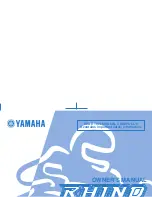
1
2
3
4
5
6
7
8
9
10
11
SAFETY CONSIDERATIONS
4-2
JC1
!
Loose Terrain
– Avoid areas of
loose terrain which may cause a
PTV to lose traction and affect
stability. Take notice of conditions
and reduce speed when driving on
uneven or loose terrain.
Pedestrian Areas
– Avoid areas
with pedestrian traffic or congested
areas whenever possible to
prevent accidents. If it is
impractical to avoid these areas,
always remember that pedestrians
have the right of way. When
approaching pedestrian or
congested area always reduce
speed, drive slowly, use caution
and watch for pedestrians.
MAINTENANCE
REQUIRED FOR PTV
SAFETY
Practice the following to help ensure
the safety of PTV occupants:
Preventative Maintenance.
Per-
form all scheduled maintenance in
accordance with manufacturer’s
recommendations to provide a
safe, properly operating PTV.
Personnel.
Allow only qualified,
trained and authorized personnel
to inspect, adjust and maintain
PTVs.
Parts and Materials.
Use only
replacement parts and materials
recommended by the manufacturer.
Ventilation
. Properly ventilate all
maintenance and storage areas in
accordance with applicable fire
codes and ordinances to avoid fire
hazards. Ventilation is required to
remove hydrogen gas from electric
powered car storage areas during
the charging process.
For electric powered PTVs, the
amount of hydrogen gas emitted
during charging depends on a
number of factors, such as the
condition of the batteries, the output
rate of the battery charger and the
amount of time the batteries are on
charge. Because of the highly
volatile nature of hydrogen gas and
its propensity to rise and accumulate
at the ceiling in pockets, a minimum
of five air changes per hour is
recommended. Consult applicable
fire and safety codes for the specific
ventilation levels requirement, as
well as requirements for the use of
explosion proof electrical apparatus.
JC1-F8199-40.qxp_LIT_19626_00_81.qxd 9/30/14 11:57 AM Page 13















































